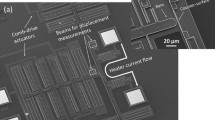Abstract
In this paper we examine the conditions for surface topography evolution and crack growth/fracture during the cyclic actuation of polysilicon microelectromechanical systems (MEMS) structures. The surface topography evolution that occurs during cyclic fatigue is shown to be stressassisted and may be predicted by linear perturbation analyses. The conditions for crack growth (due to pre-existing or nucleated cracks) are also examined within the framework of linear elastic fracture mechanics. Within this framework, we consider pre-existing cracks in the topical SiO2 layer that forms on the Si substrate in the absence of passivation. The thickening of the SiO2 that is normally observed during cyclic actuation of Si MEMS structures is shown to increase the possibility of stable crack growth by stress corrosion cracking prior to the onset of unstable crack growth in the SiO2 and Si layers. Finally, the implications of the results are discussed for the prediction of fatigue damage in silicon MEMS structures.
Similar content being viewed by others
References
Madou, M., Fundamentals of Microfabrication, 2nd edition, CRC Press, New York (2002).
Roming, A.D., “Opportunities and Challenges in MEMS Commercialization,” Vacuum Technology and Coating (2001).
Brown, S.B., Van Arsdell, W., and Muhlstein, C.L., “Materials Reliability in MEMS Devices,” International Solid State Sensors and Actuators Conference (Transducers'97), Chicago, IL (1997).
Jones, P.T., Johnson, G.C., and Howe, R.T., “Fracture Strength of Polycrystalline Silicon,” presented at Microelectromechanical Structures for Materials Research-Symposium N (1998).
LaVan, D. and Buchheit, T.E., “Testing of Critical Features of Polysilicon MEMS,” presented at Symposium MM, Materials Science of Microelectromechanical Systems (MEMS) Devices II, Boston, MA (1999).
Brown, S.B., Arsdell, W.V., and Muhlstein, C.L., “Materials Reliability in MEMS Devices,” Transducers 97, International Conference on Solid-State Sensors and Actuators, Digest of Technical Papers (1997).
Kahn, H., Ballarini, R.L., Mullen, R., andHeuer, A.H., “Electrostatically Actuated Failure of Microfabricated Polysilicon Fracture Mechanics Specimens,”Proc. Roy. Soc., Series A (Mathematical, Physical and Engineering Sciences),455,3807–3823 (1999).
Kapels, H., Aigner, R., and Bider, J., “Fracture Strength and Fatigue of Polysilicon Determined by A Novel Thermal Actuator [MEMS],” 29th European Solid-State Device Research Conference, Leuven, Belgium (1999).
Muhlstein, C.L., Brown, S., and Ritchie, R.O., “High Cycle Fatigue of Polycrystalline Silicon Thin Films in Laboratory Air,” Materials Science of Microelectromechanical System (MEMS) Devices III, Boston, MA (2000).
Muhlstein, C.L., Brown, S., andRitchie, R.O., “High Cycle Fatigue of Single Crystal Silicon Thin Film,”J. Microelectromech. Syst.,10,593–600 (2001).
Muhlstein, C.L., Howe, R.T., and Ritchie, R.O., “Fatigue of Polycrystalline Silicon for MEMS Applications: Crack Growth and Stability under Resonant Loading Conditions,” Mechanics of Materials (2002).
Allameh, S.M., Gally, B., Brown, S., and Soboyejo, W.O., “On the Evolution of Surface Morphology of Polysilicon MEMS Structures During Fatigue,” Materials Science of Microelectromechanical System (MEMS) Devices III, Boston, MA (2000).
Ritchie, R.O., “Mechanisms of Fatigue Crack Propagation in Ductile and Brittle Solids,”Int. J. Fract.,100,55–83 (1999).
Suresh, S., Fatigue of Materials, 2nd edition, Cambridge University Press (1998).
Kahn, H., Tayebi, N., Ballarini, R.L., Mullen, R., and Heuer, A.H., “Fracture Toughness of Polysilicon MEMS Devices,” 10th International Conference on Solid State Sensors and Actuators (Transducers '99), Sendai, Japan (1999).
Muhlstein, C.L., Stach, E.A., and Ritchie, R.O., “Mechanism of Fatigue in Micron-scale Films of Polycrystalline Silicon for MEMS Applications,” Appl. Phys. Lett. (2001).
Allameh, S.M., Gally, B., Brown, S., andSoboyejo, W.O., “Surface Topology and Fatigue in Si MEMS Structures,”in Mechanical Properties of Structural Films, Vol. STP 1413, 3–16, C.L. Muhlstein andS. Brown, eds., American Society for Testing and Materials, West Conshohocken, PA (2001).
Sharpe, W.N., “Variation in Mechanical Properties of Polysilicon,” 43rd International Symposium of Instrumentation Society of America, Orlando, FL (1997).
Kim, K.-S., Hurtado, J.A., andTan, H., “Evolution of Surfaceroughness Spectrum Caused by Stress in Nanometer-scale Chemical Etching,”Physical Review Letters,83,3872–3875 (1999).
Bergen, J.R., Anandan, P., Hanna, K., and Hingorani, R., “Hierarchical Model-based Motion Estimation,” Proceedings of Second European Conference on Computer Vision (1992).
Yang, W.H. andSrolovitz, D.J., “Surface Morphology Evolution in Stressed Solids: Surface Diffusion Controlled Crack Initiation,”J. Mech. Phys. Solids,42,1551–1574 (1994).
Yu, H.H. andSuo, Z., “Delayed Fracture of Ceramics Caused by Stress-dependent Surface Reactions,”Acta Meter.,47,77–88 (1999).
Mullins, R., “Theory of Thermal Grooving,”J. Appl. Phys.,28,333–339 (1957).
Srolovitz, D.J., “On the Stability of Surfaces of Stressed Solids,”Acta Metall. Mater.,37,621–625 (1989).
Yu, H.H. andSuo, Z., “Stress-dependent Surface Reactions and Implications for a Stress Measurement Technique,”J. Appl. Phys.,87,1211–1218 (2000).
Iler, R.K., Chemistry of Silica, Wiley, New York (1979).
Beuth, J.L., “Cracking of Thin Bonded Films in Residual Tension,”Int. J. Solids Struct.,29,1657–1675 (1992).
Ye, T., Suo, Z., andEvans, A.G., “Thin Film Cracking and the Roles of Substrate and Interface,”Int. J. Solids Struct.,29,2639–2648 (1992).
Lawn, B.R., Fracture of Brittle Solids, 2nd edition, Cambridge University Press, Cambridge (1993).
Author information
Authors and Affiliations
Rights and permissions
About this article
Cite this article
Shrotriya, P., Allameh, S., Brown, S. et al. Fatigue damage evolution in silicon films for micromechanical applications. Experimental Mechanics 43, 289–302 (2003). https://doi.org/10.1007/BF02410527
Received:
Revised:
Issue Date:
DOI: https://doi.org/10.1007/BF02410527




